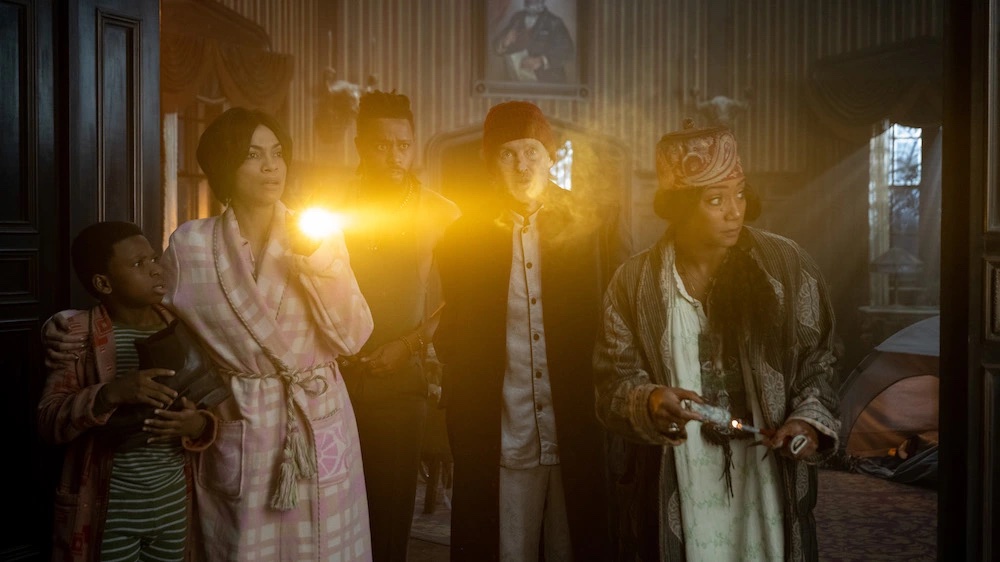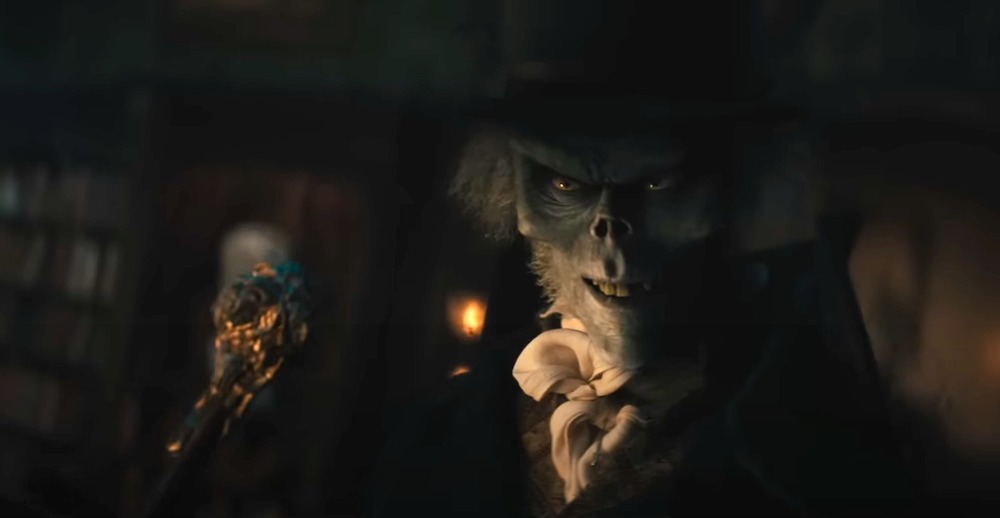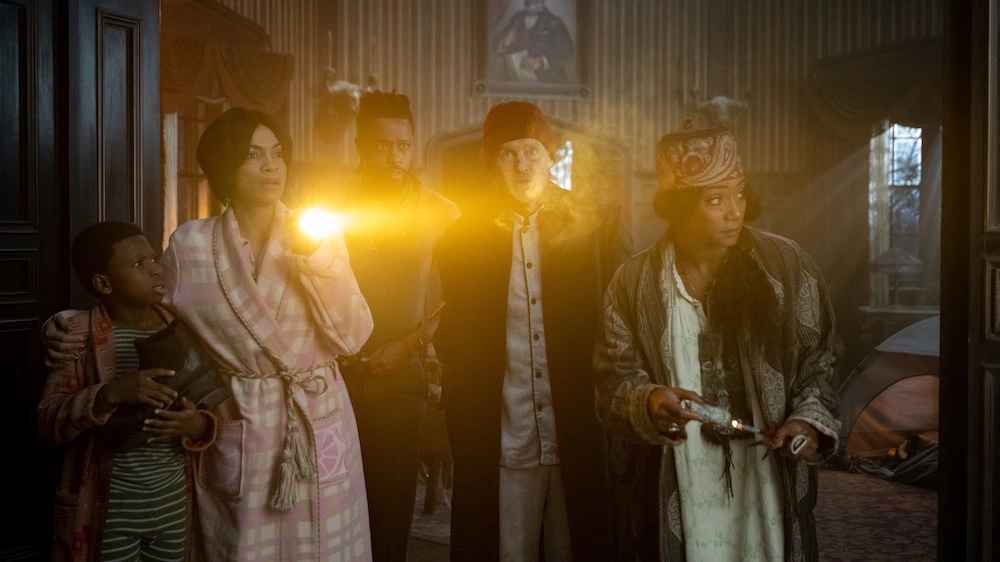
Based on a popular Disneyland ride, Haunted Mansion sends a half-dozen strangers on a quest to escape the deadly Hatbox Ghost and free the spirits he has entrapped. The film is shot by cinematographer Jeffrey Waldron, who adds a coldness and warmth to the atmosphere fitting for a movie about death.
With a cast that includes LaKeith Stanfield, Tiffany Haddish, Owen Wilson, Danny DeVito, Rosario Dawson, and Jamie Lee Curtis, Haunted Mansion follows in the tradition of theme-park based movies like Jungle Cruise and Pirates of the Caribbean.
Justin Simien (Dear White People) directed Katie Dippold‘s screenplay, which embraces the camp of the historic ride. Director of Photography Jeffrey Waldron previously worked with Simien on the acclaimed first season of Dear White People. He’s also shot shows such as The Morning Show and A League of Their Own, and he directed the award-winning documentary, Ghost Fleet. Recently, he spoke with Below the Line on a Zoom call.
Below the Line: How did you get this job?
Waldron: It’s a long story. Justin and I met on his Dear White People series on Netflix, and hit it off. We bonded over film references, general tastes, things like that. When he got the Haunted Mansion assignment, he asked if I would be interested. And I was like, “Gosh, if there was one movie I would ever want to shoot, you just named it.”
It’s a collection of everything I love, whether it be Disneyland, this ride in particular, creepy things, optical illusions. I wanted to be a Disney hand-drawn animator when I was growing up, and I made a lot of in-camera, special-effects home movies.
Just to be able to work on something of this scope, in this sort of genre, with this director, seemed like a dream come true. I built a very cohesive book, essentially what I thought would make a haunted house movie feel big and timeless and painterly. One that had a vibe that could shift between spooky and broad comedy, without it ever feeling lit like broad comedy.
BTL: What kind of problems did you face? For example, most of the film is really dark: it takes place at night, in rooms with failing lights.
Waldron: Yeah, darkness is hard. Disney darkness is extra hard because a horror film is one thing, but a Disney horror film is another thing entirely. I wanted to make sure we could see, but still feel it was dark.
I took a cue from when you’re walking around in your home without lights. The rods and cones in your eyes are less efficient. You end up with this silvery, ambient, cool light. That meant building soft boxes over each of the stages so that there would always be an ambience we had full control over. Like, can we see into the shadows?
A little bit of haze helps pick up the shadows. And then we had a filmic LUT made for this picture. We built in quite a bit of wiggle room, so that we were actually lighting quite a bit to get darkness that we could always pull up in the DI. If you look at what we shot, it’s like broad daylight brought down rather than very dark brought up.
BTL: Were you using volumes or environments?
Waldron: Basically, the whole mansion set was physical. We had a number of reshoots, but the bulk of the film — the downstairs, the ballroom, the stretching room, the main hallway — all that was a continuous space that we could shoot 360 without having to worry about VFX extensions or anything like that.
Even with the Hatbox Ghost [played by Jared Leto], there is a practical element to most of his stuff in the mansion. So we’re not just shooting a bookshelf and guessing what it’s going to look like later. We actually put one of our stunt coordinators in full wardrobe and hung him from wires. That way we could light the Hatbox Ghost so post would have a jumping off point.
Most of the clothes, textures, things like that were practical. The final graveyard was practical, although it did extend to blue screen beyond the trees. It was built in these island pieces that could be ruptured and moved.

BTL: How long was the shoot?
Waldron: I think the initial shoot was 60 days. To put that in context, the feature I did before this we shot in 16 days. Then I shot a little movie right after this in 21 days. So it was definitely gigantic for me.
I found it fascinating to see first-person what you do with 60 days. When there are all these intricacies and motion control and everything else, you always feel like you’re hustling to get your days.
BTL: Can you talk about how you shot the scenes with Jamie Lee Curtis?
Waldron: The answer isn’t that interesting in terms of cinematography; she was captured through motion control. The crystal ball was a light for everyone else.
BTL: I meant her flashback scenes. You use a striking lens where she’s in focus but the edges fall off.
Waldron: That was a custom lens I tested in pre-production. We always knew we wanted to go anamorphic, so while they were building the sets I shot tests with a variety of lenses, some spherical, some anamorphic.
I told David Dodson and Dan Sasaki at Panavision that we were doing a ghost film with flashbacks, and did you guys have anything hidden in the back room? David sent me a test from what he called a “portrait anamorphic lens.” It was a lens so anamorphisized, with such an intense aberration, that the center was in focus and the rest of the frame was this sort of glassy sphere. I don’t know what they would ever use it for except maybe as the basis for a sequence where people are looking through a crystal ball.
That lens gave us a compositional mandate to create an entire sequence that is center-punched. All these stark, center-punched compositions were really fun to storyboard, remembering that if you go too far out, you’re in the “sphere.” You’re almost looking through glass with them. The light moves through them. We started purposefully wrapping around people, moving the camera to see the interactions.
BTL: It almost looks like a silent film.
Waldron: In the DI, our colorist was Jill Bogdanowicz with Company 3. Her dad is a color scientist, I think, with Kodak in Rochester. He had created this LUT that was based on old reversal stock. By the time we finished that sequence, it almost looked like colorized black-and-white. It’s like they painted the stock with peachy skin tones. It brought a really cool vibe, especially with the oddities of the lens.

BTL: The Spirit Realm is visually just spectacular. How’d you accomplish those sequences?
Jeffrey Waldron: In the script, the Spirit Realm wasn’t described visually. It was this open-ended concept that there is an astral plane where you can see ghosts. So far the movie had largely unseen forces — then all of a sudden you’re face-to-face with a house teeming with ghosts.
What does that look like? Is it like a horror film? Or like the ride, because the ride’s full of ghosts? There was a line Ben says when he leaves the Realm, he was surprised that it was so full of life. I found that inspirational. I started to think, what does the opposite of our world look like?
I started with the idea of a film negative, pinks and purples and a deep cyan replacing the warmth of our world. I took anything that would be warm and gave it a saturated coolness. For the highlights and lamps, we leaned heavily in camera on these sort of psychedelic pinks and purples you actually see on the ride. The famous wallpaper, the sky, the purple lightning, and what we called a “Vertigo green,” the silver moon.
We went again with vintage lenses. They are chromatically aberrated, they have a smear. You can see in the candles how the colors are separating. They brought a kind of late-1960s vibe for me. The lenses were hyper-anamorphic, they had distortion which at the time was an issue they thought needed correction. Plus that sequence takes place in a hallway, which is a pretty hard place to shoot in.
BTL: So you were using vintage lenses, detuned lenses, and retuned lenses.
Waldron: I’d say the main lens we used was the T-series Anamorphic, Panavision’s more modern anamorphic. The Ghost Realm was the G-series, where we had them turn up a lot of the funkiness.
We shot with the Alexa LF, a variety of them, including the Mini. They mapped all our weird lenses so the team in post could overlay them over the work they were doing.
BTL: How many cameras were you using?
Waldron: We shot on two cameras quite a bit. There’s a good bit of dialogue in the movie, and a lot of characters. You’ve got scenes around the seance room table. You’ve got scenes where there are six or seven characters around the fire. So we often employed multiple cameras for the sake of efficiency and performance continuity.
Justin’s background is in TV, and a lot of my recent credits are in television, too. You sort of learn how to shoot two cameras in a way that doesn’t feel like you’re ever tracking to the A cam. Instead, you’re trying to find something that actually adds to the scene with B cam. So it’s not just this sort of bonus or extra bit of coverage.
BTL: We missed talking at Sundance, so tell us now about the film you made after Haunted Mansion.
Waldron: You Hurt My Feelings. That was a very funny job to do a couple of weeks after wrapping Haunted Mansion. It was good to learn that the old indie muscle was intact.
Haunted Mansion is now playing in theaters.





